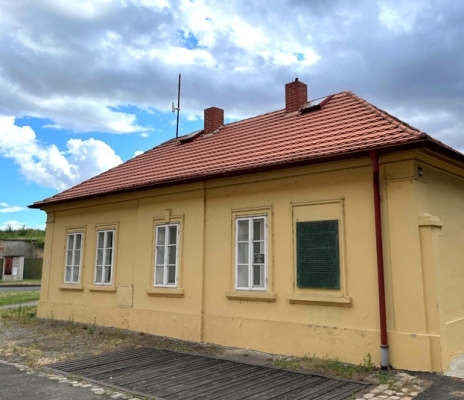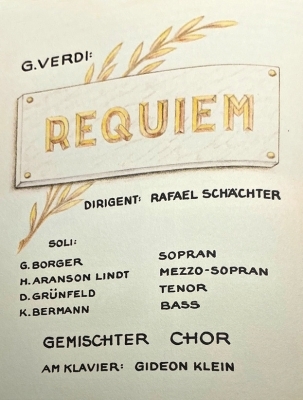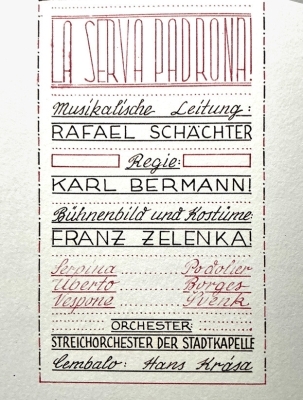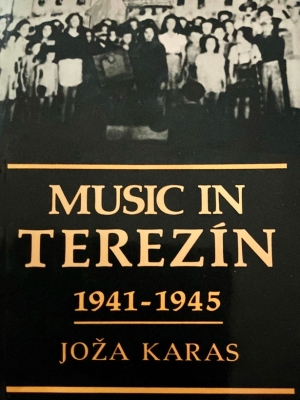Miracle in Terezin
 Train platform in Terezin for Jewish arrivals and deportation to Auschwitz, end of 1941 to spring 1945
Train platform in Terezin for Jewish arrivals and deportation to Auschwitz, end of 1941 to spring 1945
Courageous Conductor Performs A Defiant Requiem
Beginning in late 1943 and continuing until the final performance on June 23,1944, a chorus of 150 Jews imprisoned in a Nazi concentration camp engaged in 16 performances of Giuseppe Verdi's Requiem, learned by rote, from a single vocal score smuggled into the camp. The chorus, accompanied by a legless upright piano, sang before audiences of other inmates, SS officers and German army staff members. Their purpose was to sing to their captors words that could not be spoken.
The following narrative is an extraordinary saga of how Jewish prisoners in the Terezin concentration camp, situated 65 kilometers north of Prague, were motivated to learn the 85-minute-long Verdi Requiem, a Catholic liturgical Mass for the Dead. The performances in Terezin were acts of defiance and a way for prisoners to maintain their dignity in the face of unimaginable suffering. This is a story that touches on politics, power, and the manner in which a timeless choral work provided people at the nadir of human existence with a soaring sense of hope and meaning.
The man responsible for this 'miracle' in Terezin was the Jewish conductor, Rafael Schaechter, already hailed before his internment as a brilliant conductor and talented pianist with a charismatic personality.
Born in Romania in 1905, to Czech Jewish parents, he was raised and educated in Brno. He settled in Prague where he completed his studies, graduating from the Prague Conservatory in composition, piano, and conducting. In 1937 he founded the Prague Chamber Orchestra.
After the German invasion of Czechoslovakia and occupation of Prague in 1939, restrictions were placed on Jewish life, and theaters and concert halls were closed to Jews. Schaechter struggled as a piano teacher until the autumn of 1941. In November, the curtain lowered for the Jews; lists were drawn up, orders given for them to pack fifty kilos of luggage to take with them on a train to an unknown destination.
On November 30, Rafael Schaechter was deported to Terezin in one of the first transports from Prague. Among the items he packed were his piano scores, including the Verdi Requiem, recognized as possibly the most magnificent piece of choral music composed, a score close to Schaechter's heart. The Verdi Requiem would become the vehicle for sending a message of defiance to the Nazis.
On arrival, Schaechter was assigned to a construction detail digging ditches. Life was an existence of starvation, disease and despair. At night the prisoners would gather and recount the horrors enveloping them. Schaechter, surrounded by misery, understood that music could set them free.
Rafael discovered an abandoned piano in a cellar below one of the barracks. In the evening, after a long day of hard labor, he went into the basement to practice his music. With the ongoing arrival of transports from Prague, made up largely of artists, writers, singers and musicians, Rafael Schaechter became the organizer of musical life in the camp, at first, singing popular Czech folk songs, then producing a concert version of Smetana's "The Bartered Bride". He added concert performances of Mozart's "The Marriage of Figaro", and "The Magic Flute.
Terezin in 1942 was a place of extreme hardship; it saw the beginning of deportations to the east: Riga, Minsk, Treblinka. The camp was overcrowded with more than 53,000 prisoners cramped into tight bunks. Starvation and typhus ravaged the ghetto. The death rate was so high that a crematorium was built to burn the bodies, while simultaneously the Nazis attempted to maintain the facade of a model ghetto. Though nothing concrete was known by the prisoners about the "Final Solution", news percolated down; an impending sense of doom hung over the camp.
Under these circumstances, Rafael Schaechter decided on an ambitious task: to assemble a chorus of 150 amateur singers and train them to perform Verdi's monumental Requiem. Furthermore, the lyrics were in Latin and the only copy of the score was the one Rafael brought with him. The lyrics describe a day of judgement where God's wrath is poured out on sinners, where all the powerful institutions created by man are crushed to the ground. Schaechter envisioned the score as a Requiem for the Nazis, for he believed one day they would face judgement for their crimes. Expressing this explicitly would result in certain death, but Verdi's Requiem was a way they could express it safely. The Requiem also carries the hope of deliverance which resounded with the singers.
His decision to perform the Requiem created a storm with the Rabbinical Council in Terezin. There was pushback from the rabbis but Schaechter was undaunted, demonstrating to them how the words of the liturgy would be used as a weapon against their captors. He turned the words into a curse on the Day of Judgement. Inspiring his chorus, he told them: "We will sing in gratitude to Verdi and for anyone we have loved and lost." Once you read the Verdi text as a prisoner, the meaning changes. The section "Libera Me"– Deliver Me, becomes "Liberate Me" in the mind and heart of Rafael Schaechter, transforming Verdi's Requiem into a cry for liberation.
Since most of Prague's musicians and singers had been deported to Terezin, Rafael was able to recruit singers and soloists from the deportees. As soon as he had the embryo of an orchestra and small chorus he began to teach the soloists individually from the single score.
Approximately eight weeks into rehearsal, news spread throughout the camp that there would be a major transport to the east on September 6th. Against his initial wishes, Rafael acquiesced to the singers' demands to give a performance for family members. A few days later, half the chorus was deported to Auschwitz. Courageously, Rafael reconstituted a large chorus from among the remaining inmates to perform the Requiem again. The performance went on in November of 1943, but again, Adolf Eichmann, the Commandant of Terezin, organized another transport to Auschwitz which again included the majority of his second group of singers. Schaechter had no choice but to recruit new musicians and singers for a third time. His determination prevailed and he conducted fifteen more performances with the final group.
In October of 1943, Eichmann ordered Schaechter to prepare the Requiem once again; this time it was for the June 1944 visit by the International Red Cross and Danish inspectors. As a result of pressure exerted upon Eichmann by the Danish government, which was concerned about the living conditions in Terezin after 466 Danish Jews had been deported there, Eichmann gave orders for the beautification of the camp within six months, to maintain the charade of a 'model' ghetto for the Jews. The upcoming visit by the International Red Cross to Terezin was widely circulated by the Nazis as propaganda, in order to represent the camp in a most favorable way due to the circulating reports worldwide of the exterminations of Jews in the east.
In preparation for the IRC and Danish government visit, the camp was beautified; artificial shops, cafes and banks were opened and Terezin money was printed so inmates could go to a cafe or purchase used clothes from a makeshift shop. In May the Terezin town square was gentrified, grass and flowers planted, a playground built for the children and a music pavilion constructed with a new cafe. Following the completion of renovations, Eichmann was so pleased with the camouflage he arranged to produce a movie entitled "Der Fuhrer Schenk den Juden eine Stadt": The leader gives the Jews a town.
Eichmann also invited several of his top SS officers and Czech gendarmes to attend the performance of the Requiem on June 23, which was given in their honor. Having overlooked the situation of overcrowding which would be evident to the inspectors, immediately prior to the scheduled visit, seven transports carrying approximately 17,500 Jews were sent to Auschwitz to relieve the overcrowding.
On June 23, 1944, the International Red Cross and members of the Nazi high command came to Terezin for an "inspection". Rafael Schaechter and his chorus were ordered under duress to entertain the delegation with what became their last and most bittersweet performance of the Requiem. This was the powerful moment the prisoners had prepared for: they looked their captors in the eyes and sang to them of their destruction.
On October 16, 1944, four months after the final performance, Schaechter and most of the chorus were deported to Auschwitz where the majority were gassed upon arrival. Rafael Schaechter survived until the liberation of Auschwitz on January 27,1945, but subsequently died on a death march shortly before the liberation of Czechoslovakia.
What Rafael Schaechter achieved during his time at Terezin was nothing short of a miracle. After 18 months of the most determined and heroic work, he managed to put on 16 concerts of Giuseppe Verdi's Requiem with four soloists, a chorus of 150 singers and a piano in lieu of an orchestra. To achieve this he had to teach and rehearse with at least 500 prisoners, because the Nazis kept sending the singers to Auschwitz to be exterminated.
The story was patched together from the few sources available: "Music in Terezin 1941-1945," by Joza Karas; "The Terezin Requiem", a novel about Rafael Schaechter, by Josef Bor, his roommate, "Defiance at Terezin", by Mel Meckler, and the wonderful concert drama "Defiance in Terezin", researched, staged and produced by the American conductor Murray Sidlin. (If any reader would like additional information on the sources please email: This email address is being protected from spambots. You need JavaScript enabled to view it..)
Book jacket for "Music in Terezin
1941-1945." Joza Karas. Beaufort Books,
NY 1985











Comments